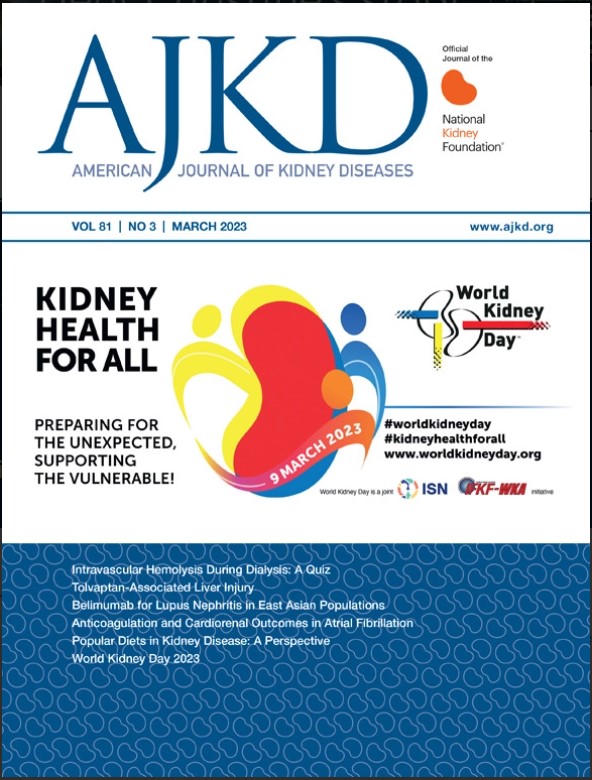别嘌醇和非布索坦对痛风和慢性肾脏病患者的疗效和安全性:STOP 痛风试验的分组分析
IF 9.4
1区 医学
Q1 UROLOGY & NEPHROLOGY
引用次数: 0
摘要
理论依据和目标:我们对患有慢性肾脏病(CKD)的试验参与者采用靶向治疗策略服用别嘌醇和非布索坦的疗效和安全性进行了预设检查:随机对照试验的预设子队列分析:STOP痛风试验的一项子研究,研究对象为慢性肾脏病患者。暴露:患有慢性肾脏病和痛风且血清尿酸盐(sUA)浓度≥6.8 mg/dL的试验参与者按1:1比例随机接受别嘌醇或非布司他治疗。降尿酸盐疗法(ULT)在第0-24周期间进行滴定,以达到目标sUA结果:第 49-72 周(第 3 阶段)痛风复发是主要结果。次要结果包括sUA目标的实现、第二阶段结束时的ULT剂量以及严重不良事件(SAE):分析方法:采用逻辑回归模型对二元结局进行比较,采用泊松回归对复发率进行比较。随后使用多变量模型,对已确定的治疗组失衡因素进行调整:940名参与者中有351人(37.3%)患有慢性肾功能衰竭,其中277人接受了主要结果评估。尽管在第二阶段结束时达到sUA目标的比例相似(79% vs. 81%; p=0.6),但随机接受别嘌醇治疗的患者在第三阶段病情发作的比例较低(32% vs. 45%; p=0.02)。与非布司他相比,急性肾损伤(AKI)在随机接受别嘌醇治疗的CKD 3期患者中更为常见:局限性:评估不常见安全事件的能力有限,主要为男性和老年人群:结论:别嘌醇和非布司他在治疗慢性肾脏病患者痛风的疗效相似,且耐受性良好。本文章由计算机程序翻译,如有差异,请以英文原文为准。
Efficacy and Safety of Allopurinol and Febuxostat in Patients With Gout and CKD: Subgroup Analysis of the STOP Gout Trial
Rationale & Objective
We conducted a prespecified examination of the efficacy and safety of allopurinol and febuxostat administered using a treat-to-target strategy in trial participants with chronic kidney disease (CKD).
Study Design
Prespecified subcohort analysis of a randomized controlled trial.
Setting & Participants
A substudy of the STOP Gout Trial in participants with CKD. CKD was defined as an estimated glomerular filtration rate (eGFR) 30-59 mL/min/1.73 m2 at baseline.
Exposure
Trial participants with CKD and gout and serum urate (SUA) concentration of ≥6.8 mg/dL were randomized 1:1 to receive allopurinol or febuxostat. Urate-lowering therapy (ULT) was titrated during weeks 0-24 to achieve a goal SUA of <6.0 mg/dL (<5.0 mg/dL with tophi) (phase 1) and maintained during weeks 25-48 (phase 2). Gout flare was assessed between weeks 49-72 (phase 3).
Outcome
Gout flare between weeks 49-72 (phase 3) was the primary outcome. Secondary outcomes included SUA goal achievement and ULT dosing at end of phase 2, and serious adverse events.
Analytical Approach
Outcomes between treatment groups were compared using logistic regression models for binary outcomes, and Poisson regression for flare rates. Multivariable models were subsequently used, adjusting for factors identified to be imbalanced by treatment arm.
Results
CKD was present in 351 of 940 participants; 277 were assessed for the primary outcome. Fewer patients randomized to allopurinol had a flare during phase 3 (32% vs 45%; P = 0.02) despite similar attainment of the SUA goal (79% vs 81%; P = 0.6) by the end of phase 2. Acute kidney injury was more common in participants with stage 3 CKD randomized to allopurinol compared with febuxostat.
Limitations
Limited power to assess infrequent safety events, largely male, older population.
Conclusions
Allopurinol and febuxostat are similarly efficacious and well-tolerated in the treatment of gout in people with CKD when used in a treat-to-target regimen with lower incidence of gout flares in participants randomized to allopurinol.
Plain-Language Summary
The STOP Gout Trial was a multicenter, randomized, double-blind, noninferiority, comparative effectiveness trial, which found that allopurinol was noninferior to febuxostat in gout flare prevention and that both medications were similarly efficacious in reaching a serum urate goal when used as part of a treat-to-target approach. A significant proportion of patients with chronic kidney disease (CKD) are afflicted by gout, yet there is a lack of high-quality comparative effectiveness data comparing allopurinol and febuxostat in these patients. We evaluated the efficacy and safety of allopurinol and febuxostat in the subgroup of STOP Gout Trial participants with stage 3 CKD and found that allopurinol and febuxostat are similarly efficacious and well-tolerated in the treatment of gout in people with CKD when used in a treat-to-target regimen, with lower incidence of gout flares in participants randomized to allopurinol.
求助全文
通过发布文献求助,成功后即可免费获取论文全文。
去求助
来源期刊

American Journal of Kidney Diseases
医学-泌尿学与肾脏学
CiteScore
20.40
自引率
2.30%
发文量
732
审稿时长
3-8 weeks
期刊介绍:
The American Journal of Kidney Diseases (AJKD), the National Kidney Foundation's official journal, is globally recognized for its leadership in clinical nephrology content. Monthly, AJKD publishes original investigations on kidney diseases, hypertension, dialysis therapies, and kidney transplantation. Rigorous peer-review, statistical scrutiny, and a structured format characterize the publication process. Each issue includes case reports unveiling new diseases and potential therapeutic strategies.
 求助内容:
求助内容: 应助结果提醒方式:
应助结果提醒方式:


